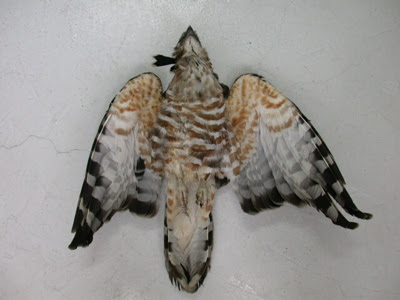With the posting of the third sighting of the Jerdon’s Baza (Aviceda jerdoni) and details of the bird feasting on a lizard, interests on the past two sightings have been generated. Thanks to Wang Luan Keng for the lead, we are posting here details of the 2002 and 2004 sightings – mainly because this passage migrant is so rare and rarely encountered in Singapore.
The first Jerdon’s Baza in Singapore was recorded on 6th December 2002 (Wang & Lim 2003). The bird probably crashed into a building and was picked up by a member of the public in Maju Camp, off Clementi Road. It died a few hours later. Upon autopsy, this bird was shown to have a bullet wound that subsequently healed. The specimen was a male (above and below).
Two years later, on the morning of 23rd January 2004, Tang Hung Bun sighted another bird at Marine City Park. He was walking with his family along Marina Promenade just after a heavy downpour when he sighted the bird perching on a branch some 40 m away. Unfortunately he had a simple point-and-shoot digital camera with him then. He only managed two shots which are reproduced below. The bird was later confirmed to be a Jerdon’s Baza. And he was told that that was only the second time the bird was sighted in Singapore.
The global range of Jerdon’s Baza as listed by Wells (1999) is SW India and Sri Lanka, the Himalayan foothills east from Darjeeling; SW Yunnan and Hainan; Southeast Asia to Sumatra, Borneo and the Philippines; and Sulawesi to the Banggai and Sula islands. According to Robson (2005), it is also seen in Peninsular Malaysia, although rarely so.
References
Robson, C. (2005). Birds of South-east Asia. London: New Holland.
Wang, L.K. & Lim, K.S. (2003). First record of Jedon’s Baza Aviceda jerdoni ) for Singapore. Singapore Avifauna 17(2):30-31 (mimeo.).
Wells, D.R. (1999). The birds of the Thai-Malay Peninsular. Vol. I, Non-passerines. Academic Press, London.
Input by Wang Luan Keng and Tang Hung Bun; images by Luan (skins) and Tang (birds).












